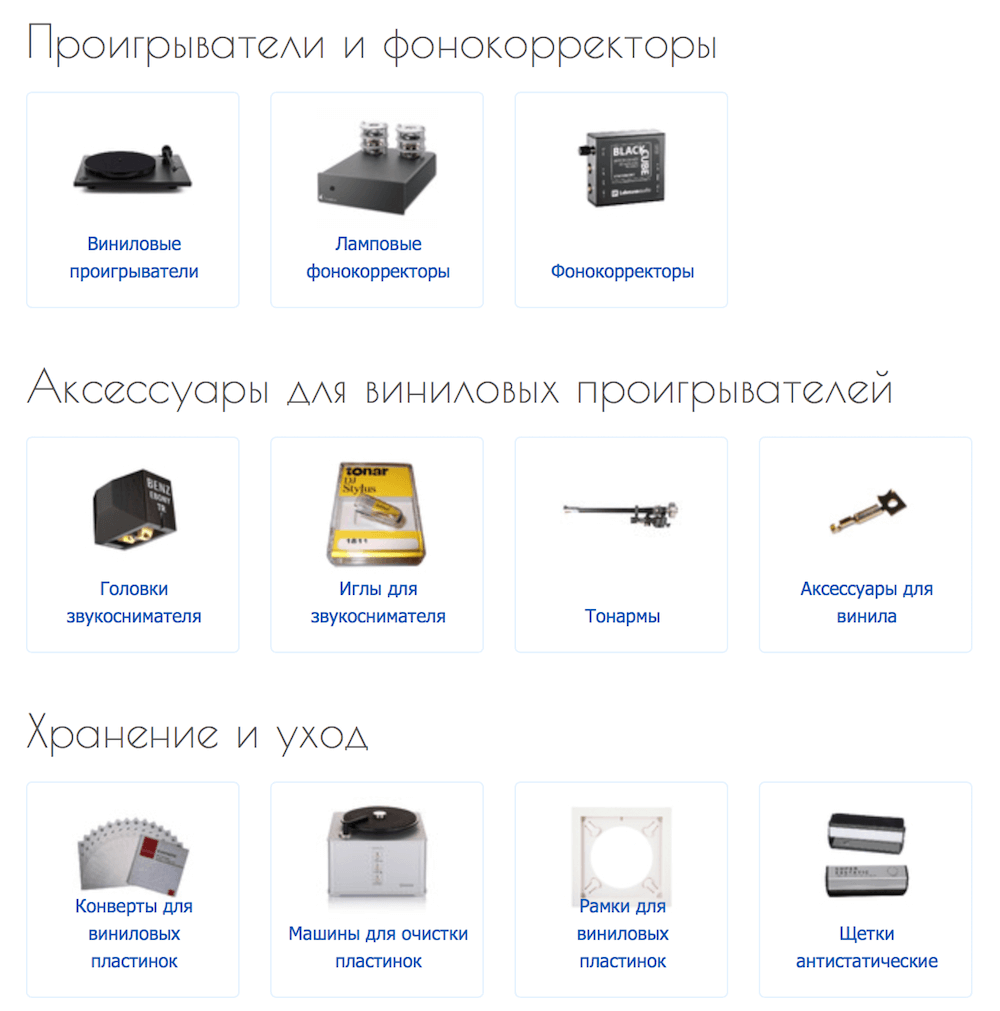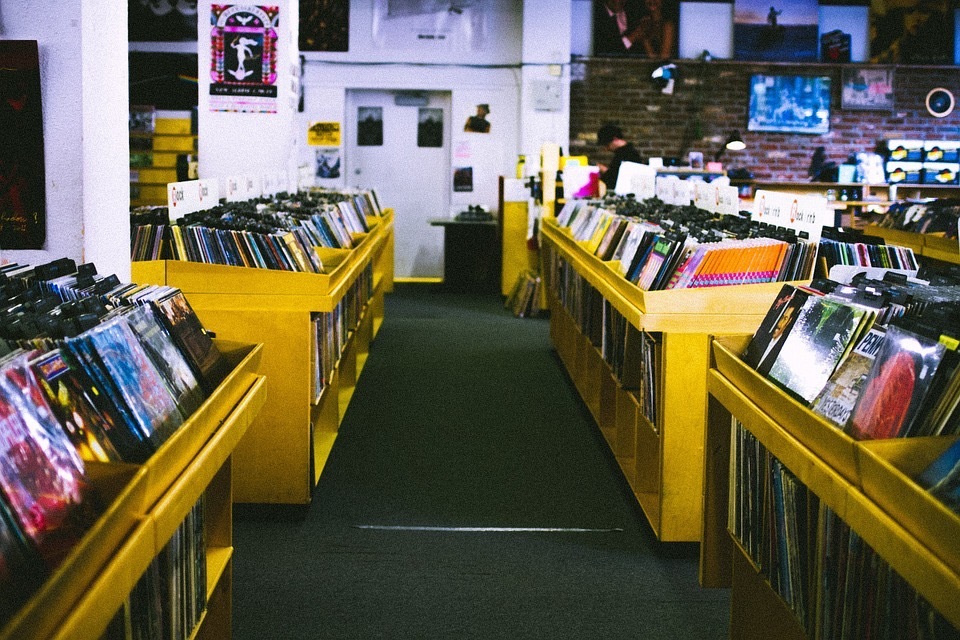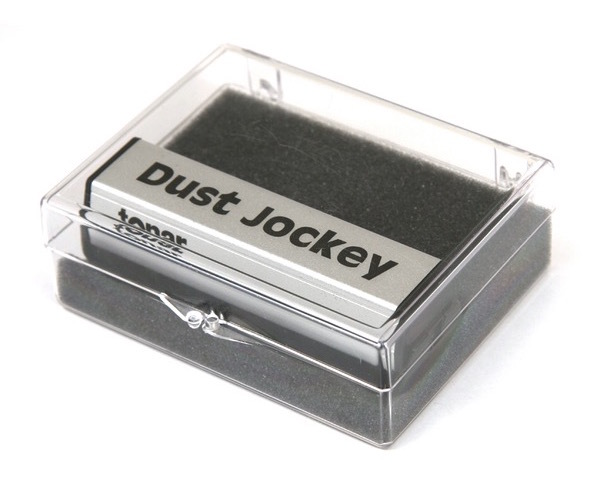Vinyl died long live vinyl

Thematic product categories related to vinyl
At the dawn of the 21st century, vinyl records are starting to appear again on the shelves of shops. In the late 90s, their popularity declined significantly - technology began to take over, and digital disks replaced them. Despite the emergence of a new media, over time, people began to return interest in vinyl, motivated by the "best" sound and connection with the past.
')
In this article, Kerim Tatevian, an expert in sound and home theater design, a music lover and a vinyl fan, will tell you how to choose a record and what features of this carrier to pay attention to music lovers who are just thinking about starting to listen to vinyl. .
At the moment, the main buyers of vinyl records are DJs and music lovers. If the former acquire them for use in their musical sets, the latter gain pleasure (besides, it is not always the record that is suitable for DJs that can be used for regular listening). They mainly buy vinyl on the primary market, where the quality of the record is perfect.
However, there are exceptions - in search of rare editions it is worth going to the secondary market. In special shops you can select the records of interest and listen to them right there. But in such stores sometimes there is no need, and you have to go to online auctions. In order not to sell cheap when selling, or vice versa, not to go bankrupt when buying a record, there is a system for assessing the state of vinyl:
* (M) Mint = Looks new, presumably not playable. This description is also acceptable for envelope states. The envelope and additional individual items, such as a song sheet, a booklet or a poster, are also in excellent condition. Plates declared as sealed or not playable must be Mint.
* (NM) Nr. Mint = Almost new, has one or two minor damage. This description is also acceptable for envelope states.
* (EX) Excellent = Plate / Separate item has some minor wear and tear, but it looks attractive anyway and is generally suitable for use. The envelope and packaging may have a slight wear and / or bends.
* (VG) Very Good = has rather serious wear and tear, but is generally presentable and the record is suitable for use, without any major defects. It is considered acceptable to have wear and wear on the envelope or on additional separate items, without any major defects.
* Good = The record was very loved and lost quite often. So often that the sound quality has deteriorated markedly, some melody distortion and surface scratches are possible. The envelope and the contents of faded, suffered from folds, worn out corners, cracked back and the like.
* Fair = The record is still playing, but it was not looked after. It produces a very tangible surface crack during playback; may even jump and jump while playing a track. The envelope and contents will be torn, stained and / or damaged.
* Poor = The disc will not play properly due to scratches and eerie surface cod. The envelope and the contents will be impressively damaged or partially lost.
* Bad = The record is no longer able to play or even broken, and can serve only for collectible purposes.
There are also special sites for evaluating retroplates (take the same Discogs ), catalogs and monographs (such are mainly published abroad), which describe how one or another record was recorded, how it was printed - this is important when evaluating the cost of vinyl. If the record turns out to be rare, then the cost of the record, respectively, will increase. On the other hand, rare and interesting recordings are exactly what distinguishes vinyl from digital media.
The plates may sound differently, and to a greater extent, it [sound] depends on the quality of the recording. If the disc was originally recorded poorly, it will be noticeable when listening to well-tuned equipment (let's talk about the setup a bit later). In such cases, it is worth looking for digital editions, because their disc writing process is much easier.
Where there is pleasure, there is responsibility
The safety of the plate is completely dependent on its owner. If it is monitored, cared for and stored properly, it will last a very long time - in fact, vinyl has no shelf life. More precisely, it directly depends on how the plate is used and how it is looked after.
Store plates need to vertically. And in any case, do not stack them on each other. Under pressure, they are deformed, which affects the sound quality.

No wonder in record stores selling vinyl, records are stored vertically. At home you can (and should) create similar storage conditions for vinyl. It does not have to be special "store" options - enough and inexpensive rack from Ikea
Do not experiment with storage space. As with any other thing, external factors affect the envelopes and plates - temperature, humidity, and so on. Therefore, in storage areas should be dry, not hot, and it is desirable that there does not get direct sunlight.
It is recommended to purchase and replace standard envelopes with antistatic ones - less dust will collect this way and the tracks of the plate will not be clogged. Dust can significantly complicate and worsen the reproduction of vinyl, moreover, it is far from always possible to determine whether there is dust on the plate at first glance - therefore, it is advisable not to neglect the antistatic envelopes. Periodically you need to clean the plates with special brushes and tools.

Antistatic brush Tonar Dust Jockey Brush
However, storage and care is not all. In addition to concerns about the safety of the disc, do not forget about its main purpose - to play music. After all, everything is being done for this. But in order for the disc to survive dozens, or even hundreds / thousands of plays, you need to properly configure the player.
Otherwise, a good record can simply be spoiled - and for this it is not necessary to play it many times, not to mention the fact that the pleasure from such listening will be doubtful. There are a large number of setup guides on the Internet, and here’s one of them. It also does not hurt to purchase special tools to adjust the player: a protractor and scales.
Important : if you buy a player with a pre-set head, the first thing to do is to check its settings, despite assurances from the manufacturer: caution will not hurt anyone. The second very important step is to replace the standard head with something more advanced, since manufacturers usually complete the players with the most budget options.

The Tonar Protractor cartridge tuning ruler avoids bias when installing a pickup head
A properly tuned player will not spoil the record, even if it is not new and got you "inherited" or bought from someone with it (for more details, we will talk in one of the upcoming issues of the podcast " Sound ").
And in conclusion, some tips for those who want to enjoy the wonderful sound of vinyl, but do not know where to start.
First - do not hurry. It is important to prioritize yourself. Why get involved in a rather troublesome by modern standards story? Do you really need it? We are accustomed to the technology of "plug'n'play", where everything is easy and simple. And vinyl needs attention. The meaning of this reflection is not to abandon the decision to buy a vinyl player and listen to records.
Rather, it is a reason to once again wonder why, why you need vinyl: nostalgia for the past, a sincere love for the special sound of vinyl, a collector's passion, or just a tribute to fashion and a desire to have something unusual? In the latter case, it is worth once again to think before spending money on a new system: vinyl requires not only monetary costs, but also temporary costs.
Secondly, you need to understand the level of your audio system. This means that if you have a serious digital system, then there is no point in starting with a budget vinyl player - you can hardly enjoy it.
If there is still a desire to try, then keep in mind that this hobby is not cheap - in addition to high-quality equipment, you will also need to buy records. It would seem obvious, but the price of rare and interesting publications (especially in high-quality packaging) can significantly exceed the cost of digital content - and this must be taken into account.
So, if you have firmly decided for yourself that vinyl is “yours”, and you are not afraid of additional expenses, then the most pleasant thing starts here: choosing from a saturated or even oversaturated offer of an assortment of stores. Not to mention the situation when an impressive record library from those times when vinyl was practically the only bearer “is inherited” to the music lover.
What else did we publish on the topic:
Source: https://habr.com/ru/post/396063/
All Articles